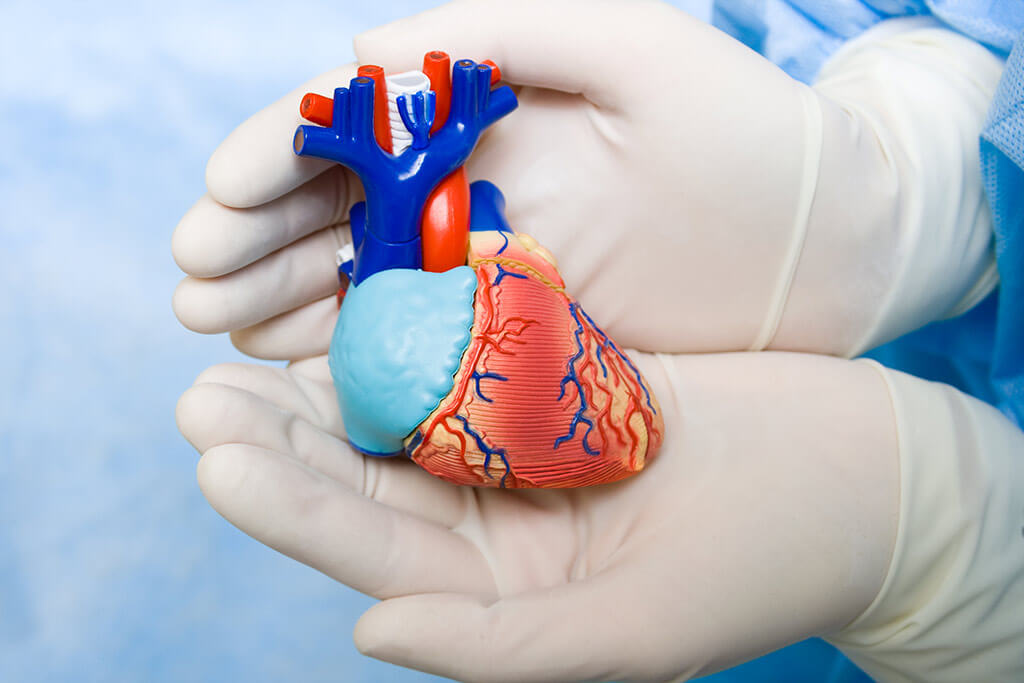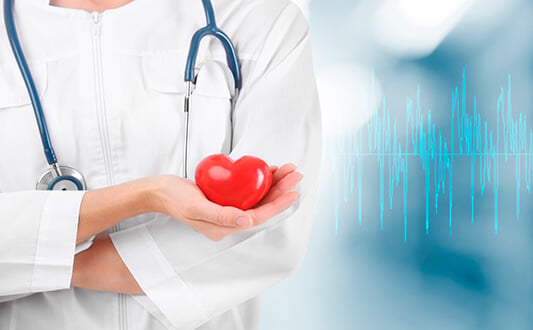Due to the development of medical technology during the last 30 years, cardiac surgeons can now choose between open surgeries and less invasive, transcatheter interventions on the aortic valve. Each technique has its own advantages, therefore, the proper selection of patients, with attention paid to the aims of the operation and its possible risks, is extremely important.
Open surgeries provide extensive surgical access, through which the cardiac surgeons can simultaneously perform interventions on several valves or other cardiac structures. However, these are serious and invasive interventions, which require a thoracotomy and the use of the heart-lung machine for 3-6 hours.
Transcatheter interventions are more sparing, they maintain the integrity of the thorax, heart walls, and large vessels. The catheter delivers the valve prosthesis and miniature surgical instruments directly to the target area. This technology even allows the surgeon to carry out the operation on patients who are high risk, as it prevents the development of irreversible changes in the left ventricle.
Content
- Aortic valve replacement techniques
- Plastic techniques which preserve a patient's own aortic valve
- Surgical techniques for interventions on the aortic valve
- Choosing a hospital and estimating treatment costs
- Treatment abroad
Aortic valve replacement techniques
The indications for aortic valve replacement include severe stenosis, birth defects (an isolated defect of the aortic valve or, more often, a combined heart defect), and severe degenerative or rheumatic lesions of the valve.
Replacement of the affected valve with a biological or mechanical prosthesis. Biological prostheses are manufactured using tissue engineering technology, they are usually based on bovine pericardium tissue. For example, this group includes various modifications of the aortic valves of the Carpentier-Edwards PERIMOUNT series.
Another option for the preparation of a biological prosthesis is an operation according to the Ozaki technique, where a new valve is made from the patient's own pericardium (pericardial sac). In these cases, the structure of the biological valve is similar to the patient's tissues, so does not cause an immunological rejection and therefore, it can be used in young women who are planning to have children in the future.
Mechanical prostheses are predominantly made of pyrolytic carbon with the addition of tungsten (it makes the valve visible to the x-ray machine). Lifelong anticoagulant therapy is required after the implantation of a mechanical prosthesis. Moreover, such valves are considered to be more durable, their service life exceeds 20-30 years.
The transplantation of a vascular valve homograft is similar to the implantation of a biological prosthesis, except that the allogeneic vessels (namely, tissues which are taken from the body of a deceased donor) serve as the material for the manufacture of the homografts. The sampling, processing, and storage of vascular homografts is regulated by the international guidelines of the European Homograft Bank. In order to improve the mechanical characteristics, valve homografts can be placed in an additional frame made of synthetic polymeric materials.
Most often, this treatment method is used in young patients, as well as in the presence of contraindications to the prolonged use of anticoagulants. Research results have confirmed the excellent long-term efficacy and safety of using vascular homografts for aortic valve replacements.
Ross procedure. During a Ross procedure, the healthy pulmonary valve is switched with an affected aortic valve. The pulmonary valve ideally substitutes the structure and function of the aortic one. The pulmonary valve is harvested from the patient at the first stage of surgical intervention. This ensures the complete immunological compatibility of prosthesis and eliminates the risk of rejection.
An epoxy-coated donor valve is implanted instead of a pulmonary valve. The effectiveness of the Ross procedure is explained by the lower load on the pulmonary valve in comparison with the aortic valve. On average, blood pressure in the aorta is always above 120 mm Hg, while normal blood pressure in the pulmonary artery does not exceed 30 mm Hg, even with the physical load. In addition, when performing the Ross procedure on a child, the replaced valve proportionately grows as the child does.
Plastic techniques which preserve a patient's own aortic valve
In some cases, cardiac surgeons prefer the reconstruction of patient's own aortic valve to its replacement. The indications for plastic surgery of the aortic valve include an isolated aortic insufficiency or stenosis with the preservation of the left ventricle function, and small structural valve defects.
"Suturing" of the aortic valve. Normally, the aortic valve has three identical leaflets which take equal part in its work. In cases of deformation or destruction of the leaflet or its part, two of them can be "sutured" together. This provides a more complete closure of the valve during the contraction of the left ventricle. At the same time, the valve function does not suffer, since the bicuspid aortic valve also develops normally, as an individual feature.
David procedure. Standard surgical tactics in aortic root aneurysms (here, the aortic valve is normally located) includes the complete replacement of the affected area. During a David procedure, the aortic valve is carefully removed from the affected aorta and subsequently transplanted into a new vascular prosthesis.
Operations that disrupt the anatomical integrity of the valve leaflets. In cases of a rupture or perforation of the aortic valve leaflets, the cardiac surgeon restores their integrity using synthetic materials or biological tissue based on the pericardium. During the intervention, a "patch" is installed on the damaged area, which is subsequently fully integrated into the tissue of the valve leaflet.
Surgical techniques for interventions on the aortic valve
In modern surgical practice, doctors use 2 basic techniques of interventions on the aortic valve. These are an open surgery and transcatheter procedure for plastic surgery or a replacement of the affected valve.
An open surgery is performed under general anesthesia, with the obligatory connection of a patient to the heart-lung machine. The cardiac surgeon makes a 25 cm cut on the sternum and opens the thorax. Open surgery provides an excellent surgical field. The heart, with all its valves and adjacent large blood and lymphatic vessels, is perfectly visible. The procedure takes 3-6 hours.
In some cases, the invasiveness of the operation can be reduced by choosing more sparing access, such as:
- Mini-thoracotomy – a 5-7 cm long incision is made along the right edge of the sternum, followed by the muscle separation and dissection of blood vessels.
- Mini-sternotomy – the surgeon cuts only the upper part of the sternum, providing limited access to the aortic valve.
- Robot-assisted intervention – the miniature endoscopic instruments are inserted into the thoracic cavity through 2-4 small incisions; further actions of the surgeon are guided by a computer and displayed on the monitor in the operating room.
Transcatheter aortic valve implantation (TAVI or TAVR) is performed without a sternotomy and connection of a patient to the heart-lung machine. It is a more sparing intervention, which can also be performed in high-risk patients – in old age, those with impaired liver and kidney function, and those with severe heart and lung diseases.
During the procedure, a catheter is inserted into the femoral artery. The aortic valve prosthesis is compactly folded at its end. Moving along the vascular system, under the control of imaging techniques (echocardiography or radiography), the catheter reaches the aorta. Here, the prosthesis is disconnected from the catheter and opened, pressing the leaflets of the damaged aortic valve to the walls of the aorta and replacing them. At the same time, unlike the open operation, the prosthesis is securely fixed in the vessel without removing the old valve. The entire procedure takes no more than 2 hours.
The efficacy and safety of the open and transcatheter aortic valve implantation was studied in several randomized multicenter clinical investigations. In particular, those were the PARTNER 2A and SURTAVI. According to their results, TAVI demonstrates similar or higher efficacy compared to traditional surgery. According to the current international recommendations of the European and American communities, the range of indications for carrying out transcatheter procedures has significantly expanded. Since 2017, patients from moderate and low risk groups are also eligible for such treatment.
Choosing a hospital and estimating treatment costs
Today, drug and surgical treatment of aortic heart defects is carried out in cardiological hospitals around the world. It is important to choose an appropriate medical facility with specialists who will provide an excellent therapeutic result, since repeated cardiac interventions are associated with high risks:
- University Hospital Essen, Department of Cardiothoracic Surgery
- University Hospital Oldenburg, Department of Cardiac Surgery
- University Hospital Ulm, Department of Cardiothoracic Surgery
- University Hospital Frankfurt am Main, Department of Cardiothoracic Surgery
- University Hospital Tuebingen, Department of Adult and Pediatric Cardiothoracic Surgery
- University Hospital Würzburg, Department of Adult and Pediatric Cardiothoracic Surgery
The average cost of treatment is as follows:
- Aortic valve replacement with biological or mechanical prosthesis – €43,400
- Transcatheter aortic valve implantation (TAVI) – €67,700
- Cardiac rehabilitation after aortic valve replacement – €1,030 per day
The total cost of the medical program depends on the necessary diagnostic procedures, the duration of hospitalization, the presence of concomitant diseases, and other factors.
Treatment abroad
While studying information about specialized cardiological centers, you should not limit yourself to hospitals in your own home country. In cases with properly prepared documentation, leading hospitals in European countries, with developed healthcare systems, accept foreign patients for treatment. If you are planning treatment abroad for the first time, it will be more convenient and reliable to use the services of the Booking Health company.
Booking Health is the provider of medical tourism that have been organizing the treatment of cardiac patients from 75 different countries in the world’s leading specialized hospitals for more than 10 years. Our specialists will provide you with constant support and will help you with the following important aspects:
- choosing the right clinic, based on the annual qualification profile;
- establishing communication directly with your doctor;
- preparing your medical program in advance, without repeating previous examinations;
- providing favorable costs, without overpricing and additional coefficients for foreign patients (saving up to 50%);
- booking an appointment on the necessary date, the possibility of urgent hospitalization;
- independent monitoring of the medical program at all its stages;
- help with buying and forwarding medicines;
- communication with the clinic after the treatment’s completion;
- control of invoices and return of unspent funds;
- organization of additional examinations and cardiac rehabilitation;
- offering services of the highest level: booking hotels and plane tickets, transfer organization, interpreting services.
Please leave a request with your medical and contact information on Booking Health’s official website, and a competent medical advisor or medical coordinator will contact you on the same day.
Choose treatment abroad and you will for sure get the best results!
Authors:
This article was edited by medical experts, board-certified doctors Dr. Nadezhda Ivanisova, and Dr. Bohdan Mykhalniuk. For the treatment of the conditions referred to in the article, you must consult a doctor; the information in the article is not intended for self-medication!
Our editorial policy, which details our commitment to accuracy and transparency, is available here. Click this link to review our policies.
Sources:
Read:
Why Booking Health - questions and answers
How to make right decision when choosing the clinic and specialist
7 reasons to trust to the rating of clinics on the Booking Health portal
Don't know where to start?
Contact Booking Health







